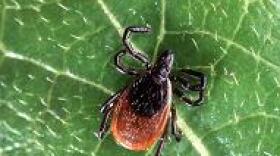The Cary Institute of Ecosystem Studies is examining the role of biodiversity in preventing pandemics. On a recent virtual discussion, two disease ecologists addressed the topic of infectious disease spillovers, and spoke about the pathogens that cause diseases like COVID-19.
The microbes that cause diseases like COVID-19, SARS, and Ebola originated in wildlife before making the jump to people. Rick Ostfeld is a Distinguished Senior Scientist at the Millbrook-based Cary Institute.
“I think the COVID pandemic is perhaps not unprecedented but, at least in the past century or so it is in the sense of how many cases there have been, how quickly and with what impact on human health, well-being and livelihoods,” Ostfeld says.
Felicia Keesing is the David & Rosalie Rose Distinguished Professor of the Sciences, Mathematics, and Computing at Bard College. She talks about the origin of COVID-19.
“We are confident that it’s a zoonotic disease because it’s closely related to SARS-CoV-1, which, that’s why it’s called, the virus that causes COVID-19 is SARS-CoV-2. It’s so similar that we’ve named it with just a second version, or a second type of this virus, this larger group of viruses. And that one is zoonotic as well,” says Keesing. “So we’re confident that it’s a zoonotic pathogen, but we’ve never found the host that it comes from definitively. You may have heard that it’s bats or that it’s pangolin, the particular kind of scaly, anteater-like mammal. Those are just the closest of the ones we found.”
She says to learn where a zoonotic disease came from, scientists usually sample various species they think might be the source, and look for viruses those species are carrying. Then they look for genetic matches between, say, a virus in an animal and the virus in a human.
“If we find a virus that has a 100 percent match with people, then we might infer from that that that species must be the one that gave the virus to us. And I say all this because it’s really important to recognize that if we gave the virus to another species, it would also have a 100 percent genetic match. And, in fact, that’s what we see with the virus that causes COVID-19. The virus is called SARS-CoV-2,” Keesing says. “We have a lot of animals now that have a 100 percent genetic match with the virus we’re carrying, but every single one of those species got it from us. We have not found the one that gave it to us and, at this point, that might be very difficult to do but we know that we can give it to a lot of other species, and we already have.”
Keesing and Ostfeld spoke about a range of zoonotic diseases.
“Roughly three-quarters of emerging infectious diseases of humans are cause by these zoonotic diseases,” says Keesing.
Cary President Josh Ginsberg sums up a longer explanation from Ostfeld about why perhaps rats present more of a problem if left to proliferate than say, a rhino.
“It’s not that biodiversity is dangerous and, in fact, it’s only very particular parts of an ecosystem or members of that community that present a threat to humans but that, unfortunately, a) because of their ‘live fast, die young, leave lots of kids’ approach to life, they’re the ones who don’t go extinct, they’re the ones who can survive human interference just fine,” says Ginsburg. “And that, even worse, by killing off other species and reducing the diversity in an ecosystem, we well may be increasing our disease risk by opening up space for the things that can deal with the disease and pass it on to us.”
The scientists talked about ways to preserve and promote biodiversity, including reducing carbon pollution, consuming fewer animal products and supporting science-based decision making. Keesing says science is on the ballot in the November election.
“Those of us who are in the United States and able to vote have a chance to make our voices heard very shortly. And this is a really pivotal election in the United States for thinking about whether we want to have science and science-based decision making playing a role as we go forward and rebuild, the sort of build back better theme I think is important to bring in here,” Keesing says. “We are going to need to rebuild our economy in different ways, our energy infrastructure, our employment infrastructure, our health infrastructure and our environmental infrastructure as we come back from this, and informed, if we’re wise, informed by this experience we can do a better job so that we make this less likely to ever happen again.”
The scientists say habitat protection and saving species are some of the ways to stem biodiversity loss and ultimately safeguard global health by reducing the stage for disease spillover events.






